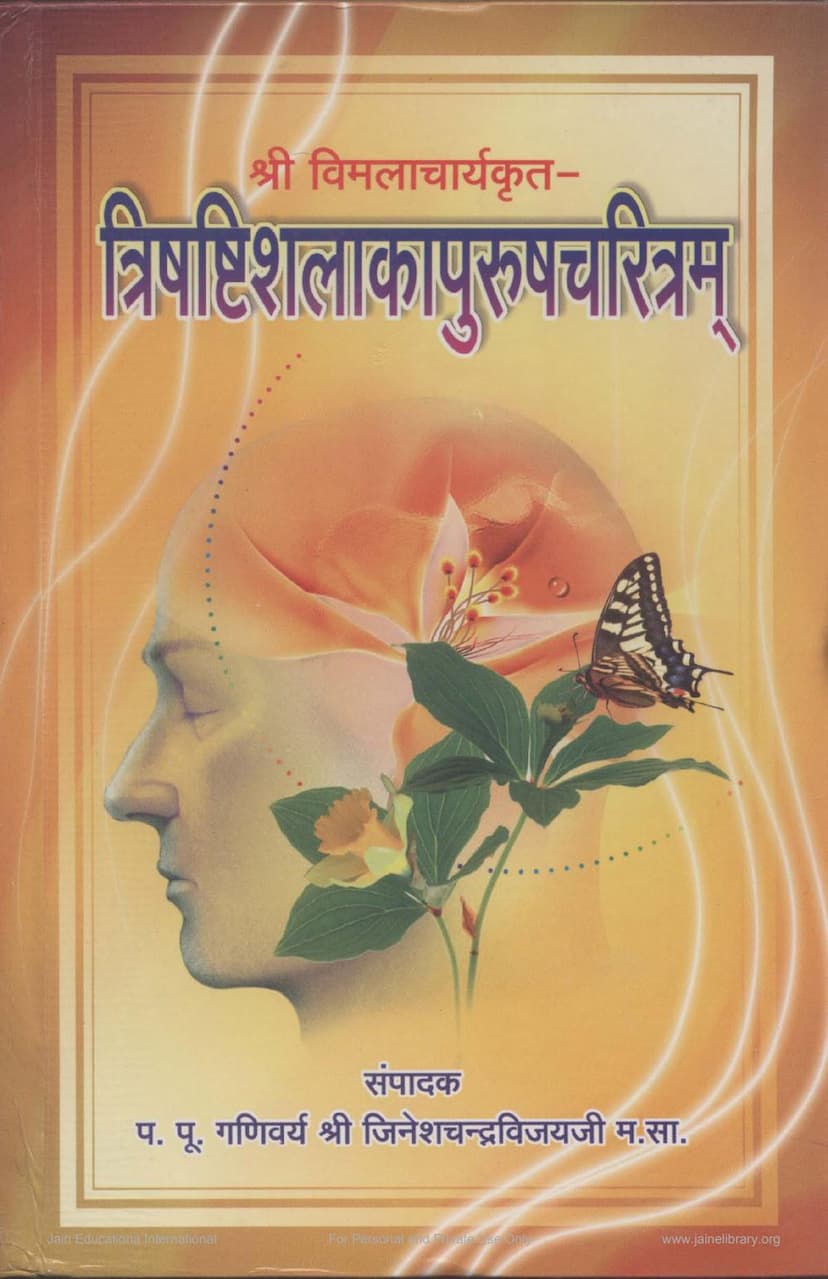Trishashti Shalaka Purush Charitram
Added to library: September 2, 2025

Summary
This is a comprehensive summary of the "Trishashti Shalaka Purusha Charitra" by Acharya Vimalsuri, as edited by Gani Shri Jineschandra Vijayji, and published by Shri Rander Road Jain Sangh, Surat.
Title: Trishashti Shalaka Purusha Charitra (Text of the Sixty-Three Great Persons) Author: Acharya Vimalasuri Editor: Gani Shri Jineschandra Vijayji M.S.A. Publisher: Shri Rander Road Jain Sangh, Surat Date of Publication: Mahasud 9, Friday, 15-2-2008 (Vir Samvat 2534)
Introduction:
The book is presented with the blessings of Acharya Shri Vijay Chandrodayasurishwarji M.S.A. and Acharya Shri Vijay Ashokchandrasurishwarji M.S.A., who initiated the "Shri Nemividyanandsuriji Granthamala" series to continue the scholarly work of their guru Maharaj. This specific volume, the 34th in the series, is the "Trishashti Shalaka Purusha Charitra" (in prose) authored by Acharya Vimalasuri. The publication received financial support from Babu Amichand Panalal Shri Adishwarji Jain Temple Trust, Walkeshwar, Mumbai.
About the Work and its Origin:
The "Trishashti Shalaka Purusha Charitra" is a significant Jain scripture that details the lives of the sixty-three illustrious figures in Jainism. These figures include the 24 Tirthankaras, 12 Chakravartis (Universal Monarchs), 9 Vasudevas (Baladevas), and 9 Prativasudevas (Vasus). The ultimate source of this knowledge is traced back to the "Drishtivada," the 12th Anga of the Jain Agamas, particularly its fifth division, "Chulika," and its fourth division, "Anuyoga."
The text highlights the efforts of various Acharyas in preserving and compiling these narratives. Acharya Rishabhamasuri is credited with reviving the "Prathamanuyoga" which contained these biographies. Acharya Hemchandracharya's Sanskrit rendition, "Trishashti Shalaka Purusha Charitra," gained immense popularity, leading to numerous commentaries and adaptations by later Acharyas, including Acharya Vimalasuri.
Acharya Vimalasuri's Contribution:
Acharya Vimalasuri's work is noted for its prose format, making the complex narratives of the "Shalaka Purushas" more accessible. He followed the sequence of events as described by Hemchandracharya but aimed for brevity and simplicity, avoiding extensive descriptions of seasons or elaborate prose. The editor notes that while Vimalasuri's prose is simple, the interspersed verses (which appear to be from the 13th century) might require scholarly interpretation. The work, as found, is incomplete, extending up to the life of Mallinath Bhagwan. The editor mentions completing the remaining portion to ensure the text's completeness.
Methodology of Research:
The research for this edition was based on two palm-leaf manuscripts of Acharya Vimalasuri's "Trishashti Shalaka Purusha Charitra" (partially complete). One manuscript, from the Shri Jinnadrasuriji Gyan Bhandar in Jaisalmer, goes up to Shantinath Bhagwan. The other, from Shri Khetaravasi's Bhandar in Patan, extends up to Mallinath Bhagwan. The editor notes that there are no significant textual variations between the two manuscripts, and they are in good condition.
Key Features and Content:
The text begins with a detailed invocation (Mangalacharan) and then proceeds to narrate the lives of the "Shalaka Purushas." The summary provides a brief overview of the content covered, starting with the life of Adinath Bhagwan, detailing his various lifetimes, the lineage of Kulakars, and the establishment of the Jain path. It describes Adinath's birth, his marriages, his 100 sons, his renunciation, the long period of his begging for alms, the historic alms-giving by Shreyans Kumar on Akshay Tritiya, his attainment of Kevala Jnana, and his Nirvana. The narrative of Bharat Chakravarti, his conquest, his eventual renunciation, and his role in establishing the Jain order are also detailed.
The summary continues to outline the lives of subsequent Tirthankaras and Chakravartis, such as Ajitnath Bhagwan and Sagar Chakravarti, up to Mallinath Bhagwan. It notes that the characterizations, while simplified by Vimalasuri, are based on the detailed accounts of Hemchandracharya. The editor also includes details about the philosophical underpinnings, the origin of the "63 Shalaka Purushas" concept, and the meaning of "Shalaka."
Acknowledgements and Gratitude:
The editor expresses deep gratitude to the guiding Acharyas, the supporting trusts and organizations, the typesetters, and printers. Special mention is made of the learned monks who assisted in deciphering ancient scripts and provided valuable suggestions. The editor concludes by hoping that the readers will benefit from this work and purify their souls.
Overall:
This publication represents a significant effort to preserve and disseminate the Jain tradition's rich narrative heritage. The meticulous work of the editor and the support of various institutions have made this edition of Vimalasuri's "Trishashti Shalaka Purusha Charitra" accessible to a wider audience.